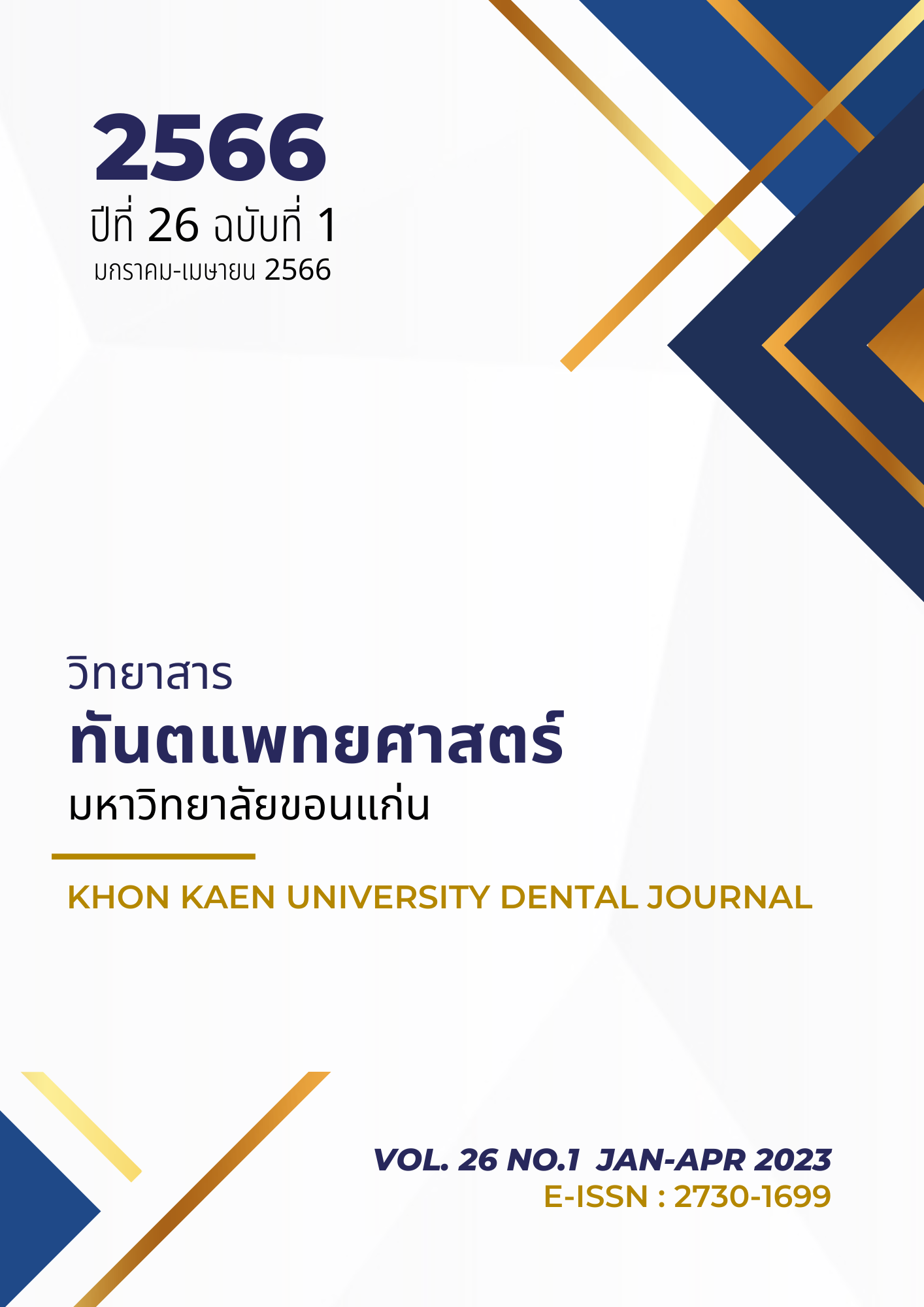Accuracy of Computer-Aided Surgical Simulation (CASS) Planning Program for Orthognathic Surgery in Skeletal Type III Relationship
Main Article Content
Abstract
Nowadays, the surgical prediction for orthognathic surgery using Computer-Aided Surgical Simulation (CASS) planning program has become the main trend in three-dimensional (3D) applications for patients with skeletal discrepancies. So, this study was aimed to assess the accuracy of surgical prediction by CASS planning program to treat two-jaw orthognathic surgery in skeletal type III non-growing patients. Nineteen participants were treated by orthodontic-orthognathic surgery. The first CBCT scans and 3D virtual model scans were presurgical recorded 2-4 weeks (T0). The simulation plans were generated by software, Simplant O & O, and were transferred to the operating room by 3D splints. The second CBCT scans were postsurgical recorded 2-6 weeks after surgical procedures or splint-off period. (T1). The differences between T0 and T1 were compared by linear and angular measurements relative to 3 planes, Frankfort Horizontal Plane (FHP), Midsagittal Plane (MSP), and Coronal Plane (CP), respectively, and statistically analyzed by one-sample t-test and intraclass correlation coefficient (ICC). For repeated measurement, ICC showed an excellent correlation (0.787–0.998). Statistically significant differences were found in U6L to FHP, L6R to MSP, PP to FHP, MP to FHP, and MP to MSP with P-value less than 0.05. The overall mean linear and angular differences were 0.57 mm and 0.93 degrees. The overall linear and angular differences were within the acceptable criteria which could be interpreted as clinical insignificance. The mean intraclass correlation coefficient was 0.94 for the simulation plans and 0.95 for the actual outcomes. The application of CASS planning program for two-jaw orthognathic surgery in skeletal class III patients had acceptable accuracy which facilitated diagnosis and surgical planning effectively.
Article Details

This work is licensed under a Creative Commons Attribution-NonCommercial-NoDerivatives 4.0 International License.
บทความ ข้อมูล เนื้อหา รูปภาพ ฯลฯ ที่ได้รับการลงตีพิมพ์ในวิทยาสารทันตแพทยศาสตร์ มหาวิทยาลัยขอนแก่นถือเป็นลิขสิทธิ์เฉพาะของคณะทันตแพทยศาสตร์ มหาวิทยาลัยขอนแก่น หากบุคคลหรือหน่วยงานใดต้องการนำทั้งหมดหรือส่วนหนึ่งส่วนใดไปเผยแพร่ต่อหรือเพื่อกระทำการใด ๆ จะต้องได้รับอนุญาตเป็นลายลักษณ์อักษร จากคณะทันตแพทยศาสตร์ มหาวิทยาลัยขอนแก่นก่อนเท่านั้น
References
WH Bell. Le Forte I osteotomy for correction of maxillary deformities. J Oral Surg 1975. 33(6):412-26.
BN Epker, LM Wolford. Middle-third facial osteotomies: their use in the correction of acquired and developmental dentofacial and craniofacial deformities. J Oral Surg 1975. 33(7): 491-514.
J Gateno, KK Forrest, B Camp. A comparison of 3 methods of face-bow transfer recording: implications for orthognathic surgery. J Oral Maxillofac Surg 2001;59(6):635-40
J Gateno, J Xia, JF Teichgraeber, A Rosen. A new technique for the creation of a computerized composite skull model. J Oral Maxillofac Surg 2003;61(2):222-7.
G Santler. 3-D COSMOS: a new 3-D model based computerised operation simulation and navigation system. J Craniomaxillofac Surg 2000; 28(5):287-93.
G Santler, H Karcher, R Kern. [Stereolithography models vs. milled 3D models. Production, indications, accuracy]. Mund Kiefer Gesichtschir, 1998;2(2):91-5.
GR Swennen, W Mollemans, F Schutyser. Three-dimensional treatment planning of orthognathic surgery in the era of virtual imaging. J Oral Maxillofac Surg 2009;67(10):2080-92.
MJ Troulis, P Everett, EB Seldin, R Kikinis, LB Kaban. Development of a three-dimensional treatment planning system based on computed tomographic data. Int J Oral Maxillofac Surg 2002; 31(4):349-57.
JJ Xia, J Gateno, JF Teichgraeber. Three-dimensional computer-aided surgical simulation for maxillofacial surgery. Atlas Oral Maxillofac Surg Clin North Am 2005;13(1):25-39.
SS Hsu, J Gateno, RB Bell, DL Hirsch, MR Markiewicz, JF Teichgraeber, et al. Accuracy of a computer-aided surgical simulation protocol for orthognathic surgery: a prospective multicenter study. J Oral Maxillofac Surg 2013 ;71(1):128-42.
YJ Chang, SS Lin, TJ Wu, WC Tsai, WY Hsu, JP Lai. The apllication of computer-aided three-dimensional simulation and prediction in orthognathic surgery (CASPOS) for treating dento-skeletal patients orthognathic surgery. J. Taiwan Assoc. Orthod 2013;25(2):93-102.
HH Lin, HW Chang, CH Wang, SG Kim, LJ Lo. Three-Dimensional Computer-Assisted Orthognathic Surgery Experience of 37 Patients. Annals of Plastic Surgery 2015;74:S118-26.
O Donatsky, J Bjorn-Jorgensen, M Holmqvist-Larsen, S Hillerup. Computerized cephalometric evaluation of orthognathic surgical precision and stability in relation to maxillary superior repositioning combined with mandibular advancement or setback. J Oral Maxillofac Surg 1997;55(10): 1071-9;discussion 1079-80.
TK Ong, RJ Banks, A.J. Hildreth. Surgical accuracy in Le Fort I maxillary osteotomies. Br J Oral Maxillofac Surg 2001;39(2):96-102.
BL Padwa, MO Kaiser, LB Kaban. Occlusal cant in the frontal plane as a reflection of facial asymmetry. J Oral Maxillofac Surg 1997;55(8): 811-6;discussion 817.
TT Tng, TC Chan, U Hagg, MS Cooke. Validity of cephalometric landmarks. An experimental study on human skulls. Eur J Orthod 1994;16(2):110-20.
NH Tran, S Tantidhnazet, S Raocharernporn, S Kiattavornchareon, V Pairuchvej, N Wongsirichat. Accuracy of Three-Dimensional Planning in Surgery-First Orthognathic Surgery: Planning Versus Outcome. J Clin Med Res 2018;10(5): 429-36.
RJ Peterman, SJ Jiang, R Johe, PM Mukherjee. Accuracy of Dolphin visual treatment objective (VTO) prediction software on class III patients treated with maxillary advancement and mandibular setback. Prog Orthod 2016;17(1):19.
N Zhang, S Liu, Z Hu, J Hu, S Zhu, Y Li. Accuracy of virtual surgical planning in two-jaw orthognathic surgery: comparison of planned and actual results. Oral Surg Oral Med Oral Pathol Oral Radiol 2016;122(2):143-51.


